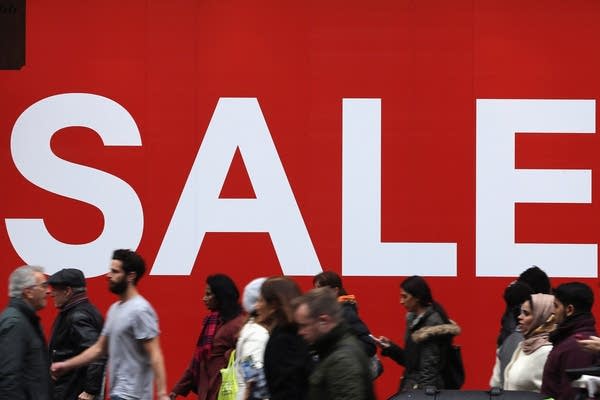How sales and coupons persuade consumers to spend more money
Go Deeper.
Create an account or log in to save stories.
Like this?
Thanks for liking this story! We have added it to a list of your favorite stories.

When J.C. Penney hired CEO Ron Johnson in 2011 to turn around the retailer, there was hope that simplifying the company's pricing strategy would woo back consumers. J.C. Penney eliminated sales and coupons, offering its customers cheaper everyday prices.
The change led to "quarter after quarter of abysmal sales, repeated barrages of layoffs and a gross lack of customers," according to the Associated Press. Some took this to be a clear sign: Consumers crave big sales and coupons over day-to-day deals.
From Science News:
Turn Up Your Support
MPR News helps you turn down the noise and build shared understanding. Turn up your support for this public resource and keep trusted journalism accessible to all.
By not showing marked-down prices, Penney's removed an element that helps shoppers feel rational. Seeing that marked-down price next to a higher original price provides an important yardstick for gauging whether we should buy something.
The original price of a sale item provides what sociologists and marketers refer to as anchoring. It brings a sense of certainty to the uncertain, giving the shopper a wisp of information for evaluating purchases. Since most of us are pretty disconnected from where our products come from and how they are made, we often use price as a major data point when it comes to evaluating whether that sweater, headset or jar of jam is worth buying. We see a $14 shirt, and conclude based on its price that it must be a low-quality garment made in a sweatshop somewhere by overworked, underpaid workers. On the other hand, seeing a red line through the $50 price tag on a shirt that's marked down to $14 indicates to us that the shirt is of high quality and that for $14, it is a steal.
The influence of this anchor price is comforting; it lends an air of rationality to our decision making. But in reality, there's little that's rational about it.
In a Reuters report earlier this year, J.C. Penney spokeswoman Daphne Avila admitted in a statement that the company was returning to a mark-up-to-mark-down strategy:
"While our prices continue to represent a tremendous value every day, we now understand that customers are motivated by promotions and prefer to receive discounts through sales and coupons applied at the register," Avila said.
Under the strategy, an Arizona crewneck T-shirt that had an "everyday" price of $5 now has a $6 price tag to allow Penney more room to offer a markdown and arrive at the same price, the spokeswoman added.
We discuss the psychology of shopping deals and how retailers are using that data to reel in consumers.

LEARN MORE ABOUT THE PSYCHOLOGY BEHIND SHOPPING:
• J.C. Penney to Revise Pricing Methods and Limit Promotions
From 2002 to 2011, the average cost that Penney paid for an item stayed about the same, from $9 to $10. During that period, though, Penney increased the average price tag to $36 from about $27. Yet even as the price tag rose, customers ended up paying less because of coupons or sales. "Now most things are on 60 percent markdown, and every time we do that, we're discounting Penney's brand," Johnson said. (The New York Times)
• How Emotions Influence What We Buy
"A nationally advertised brand has power in the marketplace because it creates an emotional connection to the consumer. A brand is nothing more than a mental representation of a product in the consumer's mind. If the representation consists only of the product's attributes, features, and other information, there are no emotional links to influence consumer preference and action. The richer the emotional content of a brand's mental representation, the more likely the consumer will be a loyal user." (Psychology Today)
• Decoding the Secret Language of Price Tags
Why do the prices at retailers like Costco and Target usually end in .99, but occasionally feature a quirky 7 or 4 for items in the clearance section? Obsessive shopping experts and store employees have been leaking the "secrets" behind these price-tag code numbers — which can help consumers tell the difference between a so-so sale price and an unheard-of bargain. (Time)
• What Neuroscience Tells Us About Consumer Desire
It's easy for businesses to keep track of what we buy, but harder to figure out why. Enter a nascent field called neuromarketing, which uses the tools of neuroscience to determine why we prefer some products over others. (Harvard Business School)
• Free Slurpees come with a twist: They may cost you
Those 7-Eleven folks sure must be dumb — as foxes. When they handed out 4.5 million Slurpees last July 11, a funny thing happened: Slurpee sales for the day rocketed 38%, says Nancy Smith, vice president of marketing. (USA Today)




